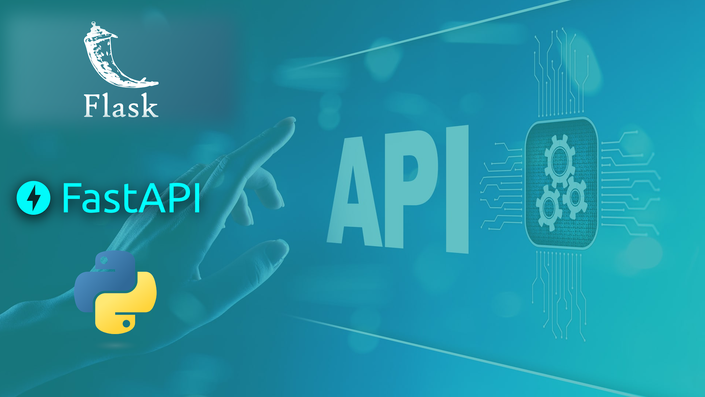
Welcome to the Python Web Developer Bootcamp
This Bootcamp includes 5 core courses and is a suitable for software developers who are beginners or advanced with Python and want to become professional Python Software Developers. You will gain hands on experience with web and software development projects using Flask, Django, FastAPI and more. You will build multiple unique Python RESTful projects and use all real world Python frameworks used in the industry.
You will also learn how to use the most popular IDE for Python called PyCharm and how to follow the PEP8 professional Python coding guidelines.
Frequently Asked Questions
How do I get started with Python?
If you are complete beginner DON'T WORRY. Our bootcamp includes a full section dedicated to Python basics. You will be able to catch up on how to declare variables, use control flow statements, use loops and more.
Does the bootcamp shows how to install Python and its frameworks?
This bootcamp has a full support for all installations you need to complete every lecture. We have lectures dedicated on how to install Python, PyCharm, how to control Python and Project versions and how to use Git.
Can I become a professional software developer with this Bootcamp?
Our bootcamp is specifically designed for beginners who want to land a job as a Python Software developers. You will start with the very basics and create multiple beginner to advanced projects that you can add them to your resume.
Can I get a refund?
Every purchase has 60 days money back guarantee. We want you to be satisfied, so all eligible courses purchased can be refunded within 14 days. For whatever reason, if you are unhappy with a course, you can request a refund.
Bundle Contents
Showcase courses, digital downloads and coaching in your Bundle.
Python Web Application Developer Bootcamp Includes
RESTful API Projects
Project 1 is called Implementing the Flask Application. It guides you through developing a terminal application that user posts and allow users to register and login. This Section will introduce you to the basic concepts of Python programming. You will learn how to parse command-line arguments to add more interactivity to programs, and you will finally see how to manage user database using the SQLAlchemy.
Project 2, Building a Web Messenger with Microservices, will teach you how to use Nameko, a microservice framework for Python. You will also learn how to make dependency providers for external resources such as Redis. This project will also touch upon integration testing Nameko services and basic AJAX requests to an API.
Project 3, Online Video Game Store with Django, will enable you to create an online video game store. It will contain features such as browsing video games by category, performing searches using different criteria, viewing detailed information about each game, and finally adding games to a shopping cart and placing an order. Here, you will learn about Django 2.0, the administration UI, the Django data model, and much more.


Flask and Fast API Projects
Project 1: Google Search
Google searches words by sending GET requests to it’s the URL with the term that is being searched as a query string parameter. So, does that mean it is an API. Technically, no, but that doesn’t mean we can’t treat it like an API and do funky stuff with it. You will build your own Google search and be able to create custom queries.
Project 2: Web Dictionary
For this exercise we will build an API that will act as dictionary for English language, the endpoint that we will define will have the following features:
- Respond with an exact match for a word when requested
- Respond with approximate matches for a word when no match is found
- Respond to list of words and not just a single word. We will also organize our code as per professional standards making use of MVC concepts.
Project 3: Image Filter API
You will use Fast API Python framework to build an image filter API. You will be able to send images to your filter dynamically and apply automatic effects to them . Fast API will allow the ensure to choose from multiple filters to apply.

Certificate of Completion

30+ Projects

40+ Hours HD Video
Python Network Programming
The Python Networking course is a great reference for computer science students, system administrators and experienced Python developers who are looking to expand their knowledge with Python Network Programming libraries. Even though the course is perfect for advanced programmers, prior experience with Python is not recommended. There are two section covering all Python basics.
Python network programming provides a broad exploration of the basic principles of the network. Python supports network programming and provides plenty of key libraries. You will also learn how to use powerful GUI applications to monitor your traffic such as Wireshark. It as a diagnostic tool for protocol research and network programming. We will also see how we can interact with Python's Wireshark with the pyshark module.
Socket Programming introduces the basics of sockets and the principles of UDP and TCP through examples involving the socket module with the IPv4 and IPv6 protocols. We will also cover asynchronous and non-blocking programming and HTTPS and TLS for the secure transport of data.
HTTP network programming covers the HTTP protocol and core Python modules such as the standard urllib library and the REST API connection request package. It also covers HTTP authentication mechanisms and how we can manage them through the request module. The Application Programming Interface in Action covers how to use Python to extract data from the major data formats on the web: HTML, XML, and JSON.


PyCharm Productivity and Debugging Techniques
Section 3: Editing and Formatting with Ease in PyCharm, offers a detailed view of how PyCharm supports the process of developing Python applications.
Section 4: Version Control with Git in PyCharm, includes a theoretical discussion about what version control is and why it is important. A hands-on tutorial on how to facilitate version control with Git in PyCharm is subsequently included, covering concepts such as adding, committing, pushing, branching, and merging.
Section 5: Seamless Testing, Debugging, and Profiling, focuses on the use of PyCharm to streamline important, yet often overlooked, processes in programming such as testing, debugging, and profiling. You will gain a theoretical understanding of what these processes are as well as hands-on knowledge of the features in PyCharm that support them.
Section 6: Web Development with JavaScript, HTML, and CSS, starts our discussion on PyCharm in the context of web applications. Here, we are concerned with the general idea “behind the web development trio languages: JavaScript, HTML, and CSS. We will explore how these languages are supported in a PyCharm environment.
Section 7: Integrating Django in PyCharm, introduces Django, the premier web development framework in Python. This chapter discusses what the Django framework is intended to do while also explaining a number of its most important features in the context of a web application.
PEP8 Guidelines: Python Clean Coding
As Guido van Rossum said, “Code is read much more often than it is written.” You may spend a few minutes, or a whole day, writing a piece of code to process user authentication. Once you’ve written it, you’re never going to write it again. But you’ll definitely have to read it again. That piece of code might remain part of a project you’re working on. Every time you go back to that file, you’ll have to remember what that code does and why you wrote it, so readability matters.
If you’re new to Python, it can be difficult to remember what a piece of code does a few days, or weeks, after you wrote it. If you follow PEP 8, you can be sure that you’ve named your variables well. You’ll know that you’ve added enough whitespace so it’s easier to follow logical steps in your code. You’ll also have commented your code well. All this will mean your code is more readable and easier to come back to. As a beginner, following the rules of PEP 8 can make learning Python a much more pleasant task.
Following PEP 8 is particularly important if you’re looking for a development job. Writing clear, readable code shows professionalism. It’ll tell an employer that you understand how to structure your code well.
If you have more experience writing Python code, then you may need to collaborate with others. Writing readable code here is crucial. Other people, who may have never met you or seen your coding style before, will have to read and understand your code. Having guidelines that you follow and recognize will make it easier for others to read your code.


Your Instructor
Martin Yanev is a master degree professional software engineer involved in software development testing and integration for the Aerospace and Medical Instrumentation industries across Europe and United States. Martin has a Bachelor degree in Aerospace Engineering and two Master Degrees in Software Engineering at Boston, US and in Aerospace Dynamics at London, UK.
Martin have gained a solid programming skills in the past 10 years being involved in the Single European Sky Project that aims to increase the European airspace capacity by applying cutting edge Air Traffic Management Systems.
Martin specializes in Java and Python, developing applications on Flask, Fast API, Spring Boot and testing them using JUnit, PyTest, Selenium and more. In the past 3 years he is dedicated to share his knowledge with everyone who wishes to become a professional software developer. He build over 100 hours on-demand HD video content covering the most common software tools used in the industry.



